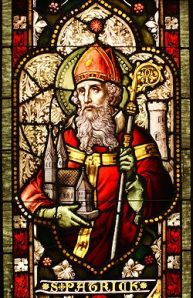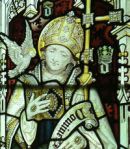 c387-460AD – Saint Patrick (Qatrikias) is born in Castell Nedd, Cymru, captured and enslaved by Irish invaders. He escaped after six years and returned to his family in Cymru, became a priest and returned to Ireland as a bishop. His name in early Irish shows the difference between the Q Celtic (Gaelic) and the P Celtic (Brythonic).
c387-460AD – Saint Patrick (Qatrikias) is born in Castell Nedd, Cymru, captured and enslaved by Irish invaders. He escaped after six years and returned to his family in Cymru, became a priest and returned to Ireland as a bishop. His name in early Irish shows the difference between the Q Celtic (Gaelic) and the P Celtic (Brythonic).
c500-589AD – Saint David is born in Pembrokeshire, becomes a priest, begins his mission of the conversion of the chieftains to Christianity, made bishop, and a saint.
chieftains to Christianity, made bishop, and a saint.
632-633AD – Cadwallon vanquished the king of Northumbria and was killed the following year.
c642-655AD – Cynddylan, son of Cyndrwyn, and his brothers stand against the Saxons at Lichfield. A few years later, he and all of his followed are murdered on ‘The Night of the Long Knifes’ in a treacherous attack. Marwnad Cynddylan and Canu Heledd are poems that have been set to mournful tunes.
754-798AD – Caradog ap Meirion reigns as king in Gwynedd. During his reign the battle at Morfa Rhuddlan is purported to have taken place in 796. According to tradition, Caradog fought Offa at Morfa Rhuddlan and the battle is commemorated in a beautiful poem by Ieuan Glan Geirionydd (Evan Evans). Two years after this bloody event, Caradog was slain by the Saxons. This link will take you to a site to hear the 9th Century folk tune to which the poem is most often sung http://carolink.tripod.com/marsh.html. Or this to hear it played on the pib Cymreig: http://www.youtube.com/watch?v=ikGp9Cxb6AM or this to see a video: http://www.youtube.com/watch?v=ZwU9gzjuCOA or my personal favorite on the harmonium at the right tempo http://www.youtube.com/watch?v=I9wRXJhhKy4&feature=related. Most folk tunes at this period were dance tunes, not dirges. The poem is one of the most beautiful I’ve read or sung. (I sang this as a solo on St. David’s Day accompanied by harp – one of the bravest things I’ve ever done!)
844-878AD – Rhodri Mawr (the Great) is king of Gwynedd, Powys and Seisyllwg (Sir Gaerfyrddin). His allies included Charles, king of the Franks. He died in battle against the Saxon king of Mercia. (Two years before this battle, 876AD, is the year in which I set the first of my Pendyffryn series with the novel, Invasion.)
880-950AD – Hywel Dda, son of Cadell and grandson of Rhodri Mawr, brings south, west and north together under his reign. He is acclaimed as one of the five great lawmakers of antiquity. The Laws of Hywel Dda were accepted as the standard of law in the judiciary in Cymru until the 16th Century. (Traitor’s Daughter is set in this period.) For more about the Marriage Laws of Hywel Dda, see my earlier article: Marriage Laws in Celtic Britain
1039-1063AD – Gruffydd ap Llywelyn, arguably the most successful of the pre-Norman kings of Cymru who, by the end of his reign, had united the whole of the country from Gwynedd to Gwent. He was the spirit of rebellion that kept the Cymry from succumbing, like their Saxon neighbors in one blow, to the power of the Normans.


